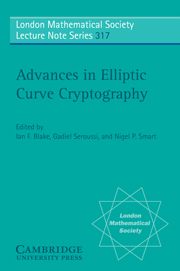Book contents
- Frontmatter
- Contents
- Preface
- Abbreviations and Standard Notation
- Authors
- Part 1 Protocols
- Chapter I Elliptic Curve Based Protocols
- Chapter II On the Provable Security of ECDSA
- Chapter III Proofs of Security for ECIES
- Part 2 Implementation Techniques
- Part 3 Mathematical Foundations
- Part 4 Pairing Based Techniques
- Bibliography
- Summary of Major LNCS Proceedings
- Author Index
- Subject Index
Chapter I - Elliptic Curve Based Protocols
Published online by Cambridge University Press: 20 August 2009
- Frontmatter
- Contents
- Preface
- Abbreviations and Standard Notation
- Authors
- Part 1 Protocols
- Chapter I Elliptic Curve Based Protocols
- Chapter II On the Provable Security of ECDSA
- Chapter III Proofs of Security for ECIES
- Part 2 Implementation Techniques
- Part 3 Mathematical Foundations
- Part 4 Pairing Based Techniques
- Bibliography
- Summary of Major LNCS Proceedings
- Author Index
- Subject Index
Summary
Introduction
In this chapter we consider the various cryptographic protocols in which elliptic curves are primarily used. We present these in greater detail than in the book [ECC] and focus on their cryptographic properties. We shall only focus on three areas: signatures, encryption and key agreement. For each of these areas we present the most important protocols, as defined by various standard bodies.
The standardization of cryptographic protocols, and elliptic curve protocols in particular, has come a long way in the last few years. Standardization is important if one wishes to deploy systems on a large scale, since different users may have different hardware/software combinations. Working to a well-defined standard for any technology aids interoperability and so should aid the takeup of the technology.
In the context of elliptic curve cryptography, standards are defined so that one knows not only the precise workings of each algorithm, but also the the format of the transmitted data. For example, a standard answers such questions as
In what format are finite field elements and elliptic curve points to be transmitted?
How are public keys to be formatted before being signed in a certificate?
How are conversions going to be performed between arbitrary bit strings to elements of finite fields, or from finite field elements to integers, and vice versa?
How are options such as the use of point compression, (see [ECC, Chapter VI]) or the choice of curve to be signalled to the user?
A number of standardization efforts have taken place, and many of these reduce the choices available to an implementor by recommending or mandating certain parameters, such as specific curves and/or specific finite fields.
- Type
- Chapter
- Information
- Advances in Elliptic Curve Cryptography , pp. 3 - 20Publisher: Cambridge University PressPrint publication year: 2005
- 2
- Cited by



